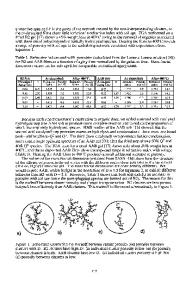Tailored Microstructures for Infrared Detection
- PDF / 2,030,092 Bytes
- 8 Pages / 417.6 x 639 pts Page_size
- 33 Downloads / 351 Views
TAILORED MICROSTRUCTURES FOR INFRARED DETECTION Quark Y. Chen and C. W. BatesJr. Dept. of Materials Science & Engineering, Stanford University, Stanford, CA 94305 Abstract Using the effective medium approximation[1-4] and the theory of photoemission from small particles,[5] we look into the design-rules of infrared materials based upon the metalsemiconductor random heterostructures with Ag particles embedded in the semiconductor. It is found that semiconductor host matrices with higher dielectric constants show better optical absorption in the infrared and that optical properties are closely related to microstructural parameters such as volume fraction of metal particles, percentage of aggregation and particle size. Cu, Ag and Au particles all show similar characteristics. We synthesized materials with small silver particles embedded in Si. Their microstructures are analysized using X-ray diffraction, electron microscopy and sputter Auger profiling. Finally, we present the optical properties of these materials and make comparisons with our theoretical results. Introduction In modem technologies for military and optical communicational applications, optical detectors are especially demanded to be highly responsive at 1.06-1.551am where optical fibers have low transmission losses. Particularly at 1.3 and 1.55gtm, the glass fiber is free from dispersion and thus has large potential bandwidth. An efficient photodetector should exhibit high rate of photoexcitation, high mobility of electron transport, high speed of response, low noise and long lifetime of free carriers. Current efforts have been to seek new materials and devices suitable for various wavelength regions and meeting the above-mentioned requirements. Up to now, the fastest devices regarding the rise time are of the photoconductive type, where values below lps have been reported.[61 Schottky junction diodes show fast rise times in the picosecond range, while it doesn't have the disadvantage of slow decay as most photoconductive detectors do.[7] Meanwhile, dark currents which may be substantial in extrinsic semiconductors can be alleviated by introducing Schottky junctions. The major difficulties in the fabrication of the Schottky diodes, however, are the insufficient transparency of contacts and parasitic capacitances. These difficulties can be overcome by making these junction contacts in the form of small metal particles dispersed in the semiconductor which are supported by insulating substrates. The total Schottky junction area is greatly increased under such circumstances. The optical absorptions and the rate of internal photoemission are also tremendously enhanced due to the confinement of conduction electrons in the metal particles. On account of the high electron densities in metals, the photosensitivities of such structures will thus be much higher than those of extrinsic semiconductors while thermal noises can be significantly reduced at the presence of Schottky barriers. The first material and device using small metal particles for optical detector
Data Loading...










